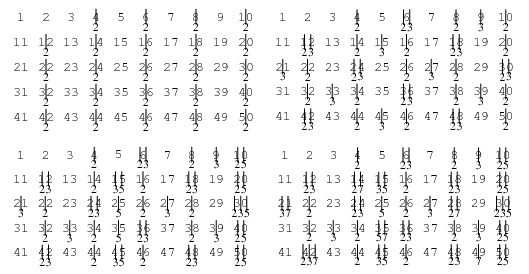Sieve of Eratosthenes

An algorithm for making tables of primes. Sequentially write down the integers from 2 to the highest number n you wish to include in the table. Cross out all numbers >2 which are divisible by 2 (every second number). Find the smallest remaining number >2. It is 3. So cross out all numbers >3 which are divisible by 3 (every third number). Find the smallest remaining number >3. It is 5. So cross out all numbers >5 which are divisible by 5 (every fifth number).
Continue until you have crossed out all numbers divisible by , where is the floor function. The numbers remaining are prime. This procedure is illustrated in the above diagram which sieves up to 50, and therefore crosses out composite numbers up to . If the procedure is then continued up to n, then the number of cross-outs gives the number of distinct prime factors of each number.
Easy Math Editor
This discussion board is a place to discuss our Daily Challenges and the math and science related to those challenges. Explanations are more than just a solution — they should explain the steps and thinking strategies that you used to obtain the solution. Comments should further the discussion of math and science.
When posting on Brilliant:
*italics*or_italics_**bold**or__bold__paragraph 1
paragraph 2
[example link](https://brilliant.org)> This is a quote# I indented these lines # 4 spaces, and now they show # up as a code block. print "hello world"\(...\)or\[...\]to ensure proper formatting.2 \times 32^{34}a_{i-1}\frac{2}{3}\sqrt{2}\sum_{i=1}^3\sin \theta\boxed{123}Comments
There are no comments in this discussion.